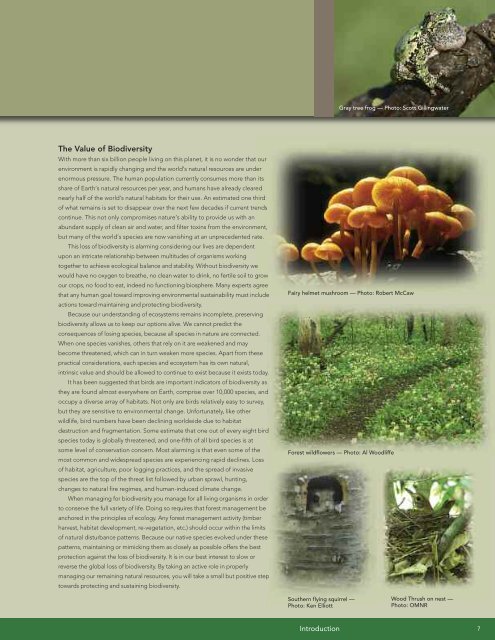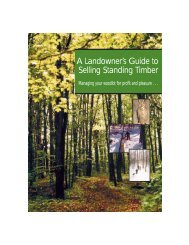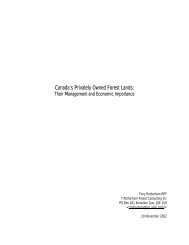A land manager's guide to conserving habitat for forest birds in ...
A land manager's guide to conserving habitat for forest birds in ...
A land manager's guide to conserving habitat for forest birds in ...
Create successful ePaper yourself
Turn your PDF publications into a flip-book with our unique Google optimized e-Paper software.
Gray tree frog — Pho<strong>to</strong>: Scott Gill<strong>in</strong>gwater<br />
The Value of Biodiversity<br />
With more than six billion people liv<strong>in</strong>g on this planet, it is no wonder that our<br />
environment is rapidly chang<strong>in</strong>g and the world’s natural resources are under<br />
enormous pressure. The human population currently consumes more than its<br />
share of Earth’s natural resources per year, and humans have already cleared<br />
nearly half of the world’s natural <strong>habitat</strong>s <strong>for</strong> their use. An estimated one third<br />
of what rema<strong>in</strong>s is set <strong>to</strong> disappear over the next few decades if current trends<br />
cont<strong>in</strong>ue. This not only compromises nature’s ability <strong>to</strong> provide us with an<br />
abundant supply of clean air and water, and filter <strong>to</strong>x<strong>in</strong>s from the environment,<br />
but many of the world’s species are now vanish<strong>in</strong>g at an unprecedented rate.<br />
This loss of biodiversity is alarm<strong>in</strong>g consider<strong>in</strong>g our lives are dependent<br />
upon an <strong>in</strong>tricate relationship between multitudes of organisms work<strong>in</strong>g<br />
<strong>to</strong>gether <strong>to</strong> achieve ecological balance and stability. Without biodiversity we<br />
would have no oxygen <strong>to</strong> breathe, no clean water <strong>to</strong> dr<strong>in</strong>k, no fertile soil <strong>to</strong> grow<br />
our crops, no food <strong>to</strong> eat, <strong>in</strong>deed no function<strong>in</strong>g biosphere. Many experts agree<br />
that any human goal <strong>to</strong>ward improv<strong>in</strong>g environmental susta<strong>in</strong>ability must <strong>in</strong>clude<br />
actions <strong>to</strong>ward ma<strong>in</strong>ta<strong>in</strong><strong>in</strong>g and protect<strong>in</strong>g biodiversity.<br />
Because our understand<strong>in</strong>g of ecosystems rema<strong>in</strong>s <strong>in</strong>complete, preserv<strong>in</strong>g<br />
biodiversity allows us <strong>to</strong> keep our options alive. We cannot predict the<br />
consequences of los<strong>in</strong>g species, because all species <strong>in</strong> nature are connected.<br />
When one species vanishes, others that rely on it are weakened and may<br />
become threatened, which can <strong>in</strong> turn weaken more species. Apart from these<br />
practical considerations, each species and ecosystem has its own natural,<br />
<strong>in</strong>tr<strong>in</strong>sic value and should be allowed <strong>to</strong> cont<strong>in</strong>ue <strong>to</strong> exist because it exists <strong>to</strong>day.<br />
It has been suggested that <strong>birds</strong> are important <strong>in</strong>dica<strong>to</strong>rs of biodiversity as<br />
they are found almost everywhere on Earth, comprise over 10,000 species, and<br />
occupy a diverse array of <strong>habitat</strong>s. Not only are <strong>birds</strong> relatively easy <strong>to</strong> survey,<br />
but they are sensitive <strong>to</strong> environmental change. Un<strong>for</strong>tunately, like other<br />
wildlife, bird numbers have been decl<strong>in</strong><strong>in</strong>g worldwide due <strong>to</strong> <strong>habitat</strong><br />
destruction and fragmentation. Some estimate that one out of every eight bird<br />
species <strong>to</strong>day is globally threatened, and one-fifth of all bird species is at<br />
some level of conservation concern. Most alarm<strong>in</strong>g is that even some of the<br />
most common and widespread species are experienc<strong>in</strong>g rapid decl<strong>in</strong>es. Loss<br />
of <strong>habitat</strong>, agriculture, poor logg<strong>in</strong>g practices, and the spread of <strong>in</strong>vasive<br />
species are the <strong>to</strong>p of the threat list followed by urban sprawl, hunt<strong>in</strong>g,<br />
changes <strong>to</strong> natural fire regimes, and human-<strong>in</strong>duced climate change.<br />
When manag<strong>in</strong>g <strong>for</strong> biodiversity you manage <strong>for</strong> all liv<strong>in</strong>g organisms <strong>in</strong> order<br />
<strong>to</strong> conserve the full variety of life. Do<strong>in</strong>g so requires that <strong>for</strong>est management be<br />
anchored <strong>in</strong> the pr<strong>in</strong>ciples of ecology. Any <strong>for</strong>est management activity (timber<br />
harvest, <strong>habitat</strong> development, re-vegetation, etc.) should occur with<strong>in</strong> the limits<br />
of natural disturbance patterns. Because our native species evolved under these<br />
patterns, ma<strong>in</strong>ta<strong>in</strong><strong>in</strong>g or mimick<strong>in</strong>g them as closely as possible offers the best<br />
protection aga<strong>in</strong>st the loss of biodiversity. It is <strong>in</strong> our best <strong>in</strong>terest <strong>to</strong> slow or<br />
reverse the global loss of biodiversity. By tak<strong>in</strong>g an active role <strong>in</strong> properly<br />
manag<strong>in</strong>g our rema<strong>in</strong><strong>in</strong>g natural resources, you will take a small but positive step<br />
<strong>to</strong>wards protect<strong>in</strong>g and susta<strong>in</strong><strong>in</strong>g biodiversity.<br />
Fairy helmet mushroom — Pho<strong>to</strong>: Robert McCaw<br />
Forest wildflowers — Pho<strong>to</strong>: Al Woodliffe<br />
Southern fly<strong>in</strong>g squirrel —<br />
Pho<strong>to</strong>: Ken Elliott<br />
Wood Thrush on nest —<br />
Pho<strong>to</strong>: OMNR<br />
Introduction 7

















